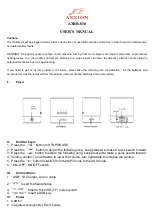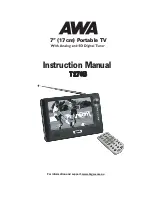
aXis CONTROLLER HOME STANDBY GENERATOR
INSTALLATION
22
14 kW Fuel System Requirements
Fuel System
Requirements
LPG
NG
Fuel Supply Inlet
3/4 in. NPT
Fuel Supply
Pressure
10 – 12 inch-H20.
(2.5 – 3.0 kPa W.C.)
5 – 7 inch-H2O
(1.2 – 1.7 kPa W.C.)
Maximum flow
rate @ 14kW
10.1 l/hr
5.3 m3/hr
Nominal Fuel Rating
LPG
2500 BTU/ft3
NG
1000 BTU/ft3
Install the fuel system in accordance with NEC and local codes.
The HSB is EPA Phase 3 certified for LPG and NG fuels.
2. fUEL CONSUMPTION
Air density is less at high altitudes, resulting in less available
engine power. Engine power will decrease 3.5% for each 1,000
feet (300 m) above sea level and 1% for each 10° F (5.5° C) above
77° F (25° C). Make sure these factors are considered when
determining total HSB load.
The gas supply and pipe MUST be sized at 100% load BTU rating.
Understand that as a specific fuel supply line pipe diameter is
extended in length, its ability to carry the volume of gas diminishes
in direct proportion. Improper fuel pipe sizing is the number one
reason for poor operating performance (hard starting, output).
Required fuel pressure for NG is 5 – 7 inches water column.
Required fuel pressure for LPG vapor is 10 – 12 inches water
column. These are estimated fuel supply requirements listed.
Refer to “Fuel Consumption Chart” above.
14 kW Fuel Consumption
Fuel Type
Percent of load
l/hr – m3/hr
LPG
0%
3.09 l/hr
50%
5.93 l/hr
100%
9.91 l/hr
NG
0%
1.8 m3/hr
50%
3.3 m3/hr
100%
5.1 m3/hr
3. NG PIPE SIZING
The HSB leaves the factory set up for NG, no changes or alteration
need to be made if NG is the fuel source you are going to use
The following NG fuel information is provided to assist the fuel
installer. This information should not be deemed to be all inclusive
or to conflict with local dry fuel codes. Consult your local fuel
supplier or Fire Marshall for guidance on proper local codes and
installations. All piping must comply with NFPA 54 and related
codes. Gas line connections should be made by a certified
plumber familiar with local codes.
Always use AGA approved gas pipe and a quality pipe sealant or
joint compound. The piping should conform to federal and local
codes, rigidly mounted and protected from vibration. Piping should
be black iron or steel to avoid reacting with the sulfur in the fuel.
DANGER
NG is highly explosive. Even the slightest spark can ignite and
cause an explosion, which could cause burns, fire or explosion
resulting in serious injury, property damage or even death. NO
leakage is permitted. Safety is important.
Gas pipe sizing is critical to the proper operation of the HSB. The
HSB fuel inlet size has no bearing on the proper gas pipe size
running to the HSB. Gas supply and pipe MUST be sized at 100%
load BTU rating. Understand that as a specific fuel supply line pipe
diameter is extended in length, its ability to carry the volume of
gas is diminished in direct proportion.
Pipe sizes are measured by inside diameter (ID) to include any
fittings, valves, elbows, tees or angles. Add 2.5 feet (.76 m) per
bend, tee or angle in the pipe line to the overall distance, for each
90 degree elbow, add 8 feet (2.4 m) to the measurement. Use a
pipe sealant or joint compound approved for use with LPG/NG on
all threaded fittings to assure zero leakage.
A dedicated NG fuel supply line pipe and primary gas regulator is
mandatory for proper operation. A minimum of one (1) approved,
external manual full flow shutoff gas valve must be installed in the
fuel supply line pipe leading to the HSB. This line must be easily
accessible.
fLEXIBLE fUEL LINE
A flexible fuel line (enclosed with the HSB) is to be installed
between the stationary fuel supply line pipe and the fuel inlet
pipe to the HSB. The purpose of the flexible fuel line is to ensure
that vibration from the HSB does not cause a gas leak at one of
the connection points. The flexible fuel line is not to be installed
underground, in contact with any enclosure parts or contact with
the ground. The entire flexible fuel line must be visible for periodic
inspection and must not be concealed within nor contact nor run
through any wall, floor, partition or fence. Never bend flexible
fuel line to avoid using an elbow. Bending the flexible fuel line
decreases its ability to absorb vibrations and could restrict the
actual fuel flow. Because a HSB engine is prone to vibration, a
flexible piping connection to the gas supply is required. Connect
the HSB to the gas supply piping with an approved flexible gas line
according to local codes. The flexible gas line also protects against
settlement between the HSB pad and the ridged gas supply piping.
















































